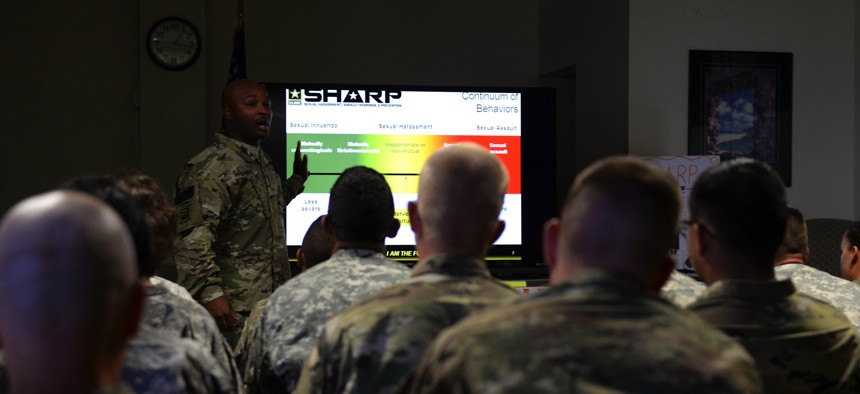
A U.S. Army staff sergeant who is a sexual harassment/assault response and prevention program victim advocate, facilitates a class at Andersen Air Force Base. U.S. Air Force / Airman 1st Class Jacob Skovo
Only a Tiny Fraction of Sexual Assaults Against DoD Civilians Are Being Documented, GAO Says
Over a recent half-decade, DoD recorded 357 cases of sexual assaults that involved civilian employees. But a survey of employees indicated that thousands may have occurred.
The Defense Department is failing to document reports of sexual assault and harassment by civilian employees, according to a new report, while giving non-military staff unequal access to programs and training aimed at protecting victims and rooting out behavior.
After conducting a survey of its workforce, Defense estimated about 2,500 civilian employees experienced sexual assault in a given year, the Government Accountability Office found in a new report. That compared to 357 recorded sexual assaults that involved civilian employee victims over a five-year period from fiscal 2015 to fiscal 2019, meaning the records had captured only about 3% of estimated cases of assault over that five-year period. Not all victims said they reported the incidents, but at least some of the failure to record the data was the result of the Pentagon’s internal shortcomings.
Defense guidance has created gaps in recording sexual assaults that left out most civilians, GAO said. Cases potentially carved out from reporting requirements included victims within the continental United States, at department agencies not directly connected to a service branch or who are also military dependents. Even within the military branches, civilians making what are classified as “informal complaints” are often not tracked or recorded, the report said.
“Without such data, DoD is limited in its ability to identify and manage civilian-related trends, analyze risk factors or problematic circumstances across the force, and take action to eliminate or mitigate risks through prevention efforts,” GAO said. Put simply, the auditors added that “DoD does not know the extent to which its civilian workforce has reported work-related sexual assault worldwide.”
The Pentagon directed its components to establish anti-harassment programs last year, but it included little detail on what those programs should look like. The guidance also failed to define the data that Defense components must collect and report, with department officials telling GAO they declined to spell out any specifics because components could not agree on what to include.
“Without expanded guidance to specify and define uniform data elements that all DoD components should use when collecting and reporting on allegations of harassment made by DoD civilian employees outside of the EEO process, DoD will likely be unable to accurately compare data across components to identify trends and analyze program effectiveness,” GAO said.
The Pentagon’s Sexual Assault Prevention and Response Office, overseen by the undersecretary of Defense for personnel and readiness, is responsible for developing policies, training, reporting and data tracking related to sexual assault. The program is only available for military personnel, their dependents and civilians outside the continental United States to make reports of sexual assault. Civilian employees can lodge complaints through the equal employment opportunity program, a non-EEO track or the military equal opportunity program. The Pentagon told GAO it is developing a central repository to track all of these complaints across its components, though officials said it has encountered difficulties in getting the initiative off the ground.
GAO also found that civilian employees do not consistently have access to resolution programs or support services. Employees at some components are eligible for legal services, for example, while those at others are not. Civilian staff are not consistently able to make "restricted reports" of assault, which provides victims access to support services without launching an investigation. Those located outside of the continental United States, however, enjoy all the same reporting protections as their military counterparts.
GAO made 19 recommendations to the Pentagon, including to issue guidance for uniform tracking of sexual harassment and assault, ensure consistent data collection across all Defense components and address shortfalls in avenues for civilian workers to report and address their assaults. Defense nearly universally agreed with GAO's findings and plans to address them.
As part of those efforts, newly sworn in Defense Secretary Lloyd Austin as his first act ordered a review of programs within the department aimed at addressing sexual assault. Pentagon spokesman John Kirby said on Tuesday each military service has already submitted a report to the Personnel and Readiness director that Austin will soon review. President Biden has taskedDefense with standing up a 90-day commission to address sexual assault within the department, and Kirby said that effort will be driven by Senior Executive Service civilians, as well as enlisted and officer military personnel.
“I'm sure the secretary will want to take a look at that and appropriately resource the commission to make sure that they are actually able to come up with tangible, practical solutions to solving this scourge,” Kirby said.
NEXT STORY: Biden: ‘I Will Never Politicize’ US Troops
